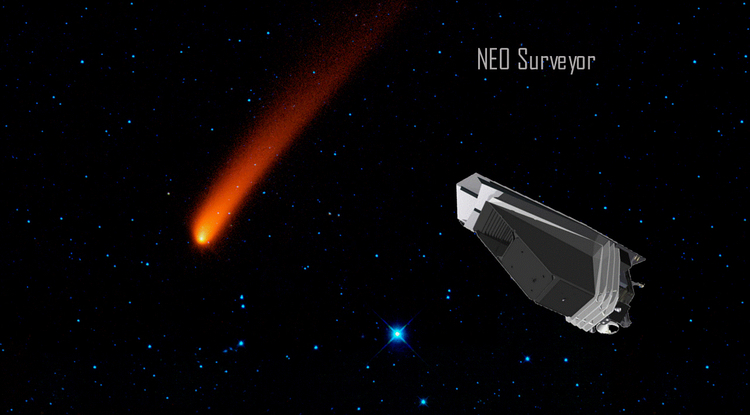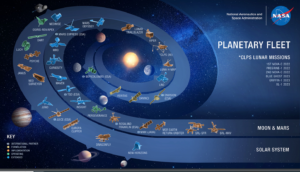5.12.2022

Five Republicans on the House science committee are asking NASA to prioritize funding for the Near Earth Object Surveyor space telescope. NEO Surveyor will hunt for asteroids and comets that might threaten Earth, but the Biden Administration proposed a deep cut to the program in FY2023 and a delay of at least two years. Republicans will control the House next year and the letter signals they are paying attention to NEO Surveyor and its goal of fulfilling a 2005 congressional mandate to identify 90 percent of NEOs 140-meters or more in diameter.
Rep. Frank Lucas (R-OK) and Rep. Brian Babin (R-TX), the top Republicans on the House Science, Space, and Technology Committee and its space subcommittee, respectively, along with Reps. Jay Obernolte (R-CA), Young Kim (R-CA) and Michael Waltz (R-FL), wrote to NASA Administrator Bill Nelson on Monday asking for details on the funding needed to keep NEO Surveyor on its original schedule.
They also asked for all correspondence between NASA and the project’s management over the past 18 months related to budget profiles.
Amy Mainzer, a professor in the Lunar and Planetary Laboratory at the University of Arizona, is Survey Director. For many years she worked at NASA’s Jet Propulsion Laboratory as Principal Investigator of NEOWISE, a spacecraft that was repurposed for asteroid hunting after its primary astrophysics mission ended. NEO Surveyor is optimized specifically to find them. JPL is building the spacecraft.
The Lucas letter underscores the committee’s decades-long interest in directing NASA to locate and catalogue large asteroids and comets — Near Earth Objects or NEOs — that would cause global or regional devastation if they impact Earth. In 1994, the House-passed FY1995 NASA authorization act (H.R. 4489) directed NASA to identify and catalogue within 10 years all comets and asteroids more than 1 kilometer in diameter whose orbits cross Earth’s orbit. A NEO in that class is thought to be responsible for the extinction of the dinosaurs 65 million years ago as debris billowed up high in the atmosphere, blocking sunlight and altering the climate.
In the 2005 NASA Authorization Act (P.L. 109-155), Congress went further: find 90 percent of NEOs 140 meters or more in diameter within 15 years. That size NEO might not wipe out entire species, but would have significant regional effects.
For comparison, the meteor that exploded over Chelyabinsk, Russia in 2013 was about 20 meters wide. More than 1,000 people were injured, mostly by flying glass from windows shattered by the shock wave from the meteor passing through the atmosphere.
The 15 years expired in 2020 and although NASA has been working diligently, Mainzer and officials in NASA’s Planetary Defense Coordination Office say it will take another 30 years or more at the current rate of discovery.
Speeding up the search requires looking for NEOs not from the surface of Earth, which limits the field of view, but from space using an infrared telescope that can locate them based on the heat they radiate. These small, dark objects are difficult to discern visually.
NASA agreed to build NEO Surveyor in 2019 and Congress funded it starting with the FY2020 budget. Launch was expected in 2026.
In the FY2023 budget request, however, the Administration proposed deep cuts. The FY2023 request is just $39.9 million compared to the $174.2 million NASA projected last year would be needed in FY2023. The launch date would slip to at least 2028.
The Lucas letter adds that NASA notified Congress in its FY2022 operating plan that it is reducing FY2022 funding from $143 million to $110 million.
NEO Surveyor is part of NASA’s planetary science division, which has a number of high visibility, expensive missions in development right now. They include Europa Clipper, a mission to Jupiter’s moon Europa that Congress directed NASA to build, and the Mars Sample Return mission to bring samples collected by the Mars Perseverance rover back to Earth, another project with strong support in Congress.

In setting priorities, NEO Surveyor clearly was not at the top of the Administration’s list. Now it’s up to Congress, which is still working on FY2023 appropriations.
The government is currently operating under a Continuing Resolution, which keeps programs funded at their FY2022 levels, until December 16. Whether they will finish the full-year appropriations this year or pass another CR is up in the air.
The House Appropriations Committee provided $94.9 million for NEO Surveyor in the Commerce-Justice-Science bill, more than the request but less than what was projected to meet a 2026 launch. The committee told NASA to provide a timeline for “launch prior to 2028” in its FY2024 request. The Senate Appropriations Committee did not reach agreement on FY2023 appropriations, but the Democratic leadership’s version of the CJS bill doubled the request and said it “welcomes NASA’s commitment to a 2026 launch date.”
The 2022 NASA Authorization Act passed Congress as part of the CHIPS and Science Act (P.L. 117-167). It also supports NEO Surveyor and requires NASA to continue development “on a schedule to achieve a launch readiness date not later than March 30, 2026, or the earliest practicable date,” but authorization bills do not provide money.
The program is progressing while the funding debate goes on. On Tuesday, a review called Key Decision Point-C or KDP-C was held to determine if it’s ready to move into the next phase of development, Phase C, final design and fabrication. NASA has not announced the results yet.
NASA’s science budget is at its highest level in history, approximately $7 billion, and the planetary science budget is about $3 billion of that. It can seem like a lot of money, but it’s a big portfolio and some projects are encountering challenges. Europa Clipper’s cost climbed from $4.25 billion to $5 billion earlier this year and NASA just postponed by three years a Venus mission, VERITAS, because a totally unrelated program, Psyche, has a big overrun and the extra money had to come from somewhere. Now the European Space Agency is looking to NASA to help get its Rosalind Franklin rover to Mars after it ended cooperation with Russia on the ExoMars program because of Russia’s invasion of Ukraine. NASA and ESA already are working together on the Mars Sample Return mission.

